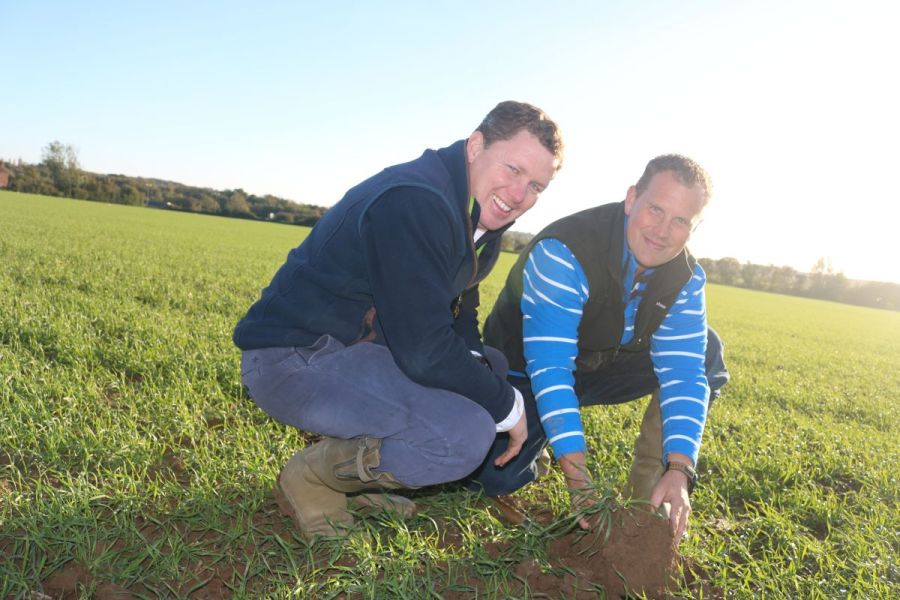A soil-led approach links the progress of two large, productive arable systems in Wiltshire and Kent. CPM visits the two farms in Agrii’s Green Horizons network to find out how environmental improvements go hand-in-hand with a firm focus on arable profitability.
“It only works where you have a relationship built on trust.”
By Tom Allen-Stevens and Rob Jones
Alan Clifton-Holt sinks his spade into the ground and eases up a clod. As he breaks open the soil, a profusion of worms startled by the intrusion, attempt to escape the exposure.
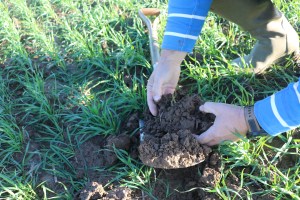
A profusion of worms show the system’s working.
“You asked how we know the system’s working,” he says. “I don’t think you can get much better proof than that.”
With soils that range from Grade one silts, through heavier silty clays to sands in Ashford Valley, AA Clifton Farms covers 1520ha of arable land spread over 50 miles from Canterbury to Romney Marsh in Kent.
These are capable of pushing out winter wheat yields in excess of 12t/ha, but by the mid-2000s, problems with blackgrass in particular had seen them dip as low as 5t/ha. “Blackgrass is the biggest risk,” says Alan, director of the family business with brother Toby and parents Robert and Anne. “We also wanted to get a grip on costs without damaging productivity.”
From 2006-2010, badly infested fields were put into grass leys, with forage taken by a local dairy farmer. “This helped the blackgrass, but the margin wasn’t good. We also made changes to the rotation and to cultivation.”
The key introduction was a double spring break crop, within a six-year rotation that also includes two winter wheats, winter barley and oilseed rape. Spring oats and spring beans are the favoured crops, and there’s 350ha of cover crops grown in front of them.
“We started in cover crops ten years ago with radishes and mustards, but quickly realised mustard attracts slugs while radishes don’t help the blackgrass.” Over the past three seasons the species mix and agronomy of the covers has been finetuned with the help of on-farm trials overseen by Agrii agronomist Neil Harper.
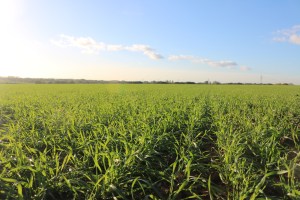
Ten years of cover crops at AA Clifton Farms have brought benefits throughout the rotation.
“We’re looking for a mix that will pull the water out of the soil, ready for spring cropping, add some structure and help with the blackgrass,” explains Neil. “So we start with a base mix of phacelia, buckwheat and linseed. Buckwheat also helps to mine the phosphate.
“Then in front of the beans we add rye to the mix, while vetch goes in front of the oats. It’s important to select the right varieties, too. Some buckwheats will flower too early, while trials have shown a marked difference with the type of vetch used.”
This was a trial conducted two years ago, notes Alan. “You could see to a line the difference between varieties, because the oats went flat in places.”
A local flock of sheep come in to graze the cover crops in January and February, but Alan’s in two minds about their value. “We did another trial comparing grazed and ungrazed cover crops with a weedy overwinter stubble, that was also ungrazed. The yield of the following spring oats was actually best in the stubble, while the grazed area was 1.5t/ha behind.”
Neil puts this down to surface compaction. “The sheep came off late and it’s also about soil type. A high silt content means it can cap badly if put under pressure when it’s wet, and spring cereal yields can then suffer if direct drilled.”
Cultivations currently follow a strategy of deep loosening and “tickling the top”, leaving as much undisturbed in between as possible. Alan explains that he assesses each field soon after harvest, with a Grange low-disturbance subsoiler used to lift areas that need it. A Pöttinger Terradisc finishes the top 50mm.
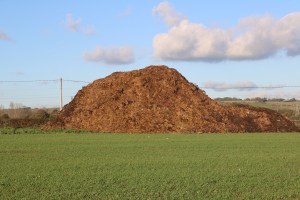
Organic amendments at AA Clifton Farms are tested before they’re spread to ensure the most is made of their value.
“We have two drills. We try to drill all the cereals with the Väderstad Rapid, that does an excellent job on the Marsh. The OSR, beans and cover crops are established with a 6m Amazone Cayena with its rigid tines.”
A straw-for-muck deal brings in manure that’s mixed with poultry litter and compost and spread judiciously. “It’s tested before it’s spread – organic amendments work best when you make the most of what you have and assess its value before it goes on,” notes Neil.
Close to the French market, Alan grows Group 3 wheats to achieve a premium without the added fertiliser costs, while he’s looking to phase out insecticides and molluscicides altogether. “Insecticides are a nuclear bomb for the soil,” he comments.
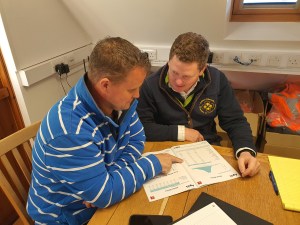
A payment-by-results arrangement rewards Neil Harper (left) based on how the farm has performed, benchmarked through Agrii’s MAP service.
He also has a novel payment-by-results arrangement for his agronomy advice. The farm is benchmarked through Agrii’s Measuring Arable Performance (MAP) service. Neil then receives a greater reward if crops perform in the top 25% of Agrii farms in the MAP programme and a lower one if they don’t.
“It only works where you have a relationship built on trust,” says Alan. “As much as I am ruthless on price for inputs, I have no problem paying for the right advice and technical expertise.
“We get really good data for a detailed discussion, and Neil is a part of that. We then share the risks of the decisions we take. This forces us to justify every step, and we’re finding more often than not, it helps reach the right decision.”
Alan’s convinced the farm is in a good position to ride out the transition as the Basic Payment falls away and take advantage of any opportunity that arises. “You have to get a grip on costs, farm efficiently and to the best of the land’s ability, but it’s also about leaving the land in a better state and learning as you go,” he says.
“We may not have all the answers, and may be farming in a very different way in five years’ time. But I’d hope the way we make decisions ensure it’s a continual improvement on all fronts.”
Balance central to Wiltshire farm approach
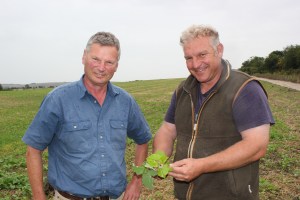
David Lemon (right) and Russell Frost check their OSR companion crop mix.
Environmental improvement and arable profitability go hand-in-hand at Manor Farm, Wilton in the heart of the North Wessex Downs just south of Marlborough. With 1200ha of arable under a broad range of share-farming to stubble-to-stubble agreements, each aspect increasingly has to support the other in a world of unprecedented change, says director David Lemon.
“Climate change makes it imperative we build more resilience into everything we do,” he says. “Our records show in the 30 years to 2006 there were only five occasions when we had more than 25mm of rain in 24hrs. Yet in the 16 years since, we’ve experienced this more than 11 times.”
The progressive loss of Single Farm Payments and escalating fertiliser, fuel and other input prices have added to the pressure on margins. So he works with Agrii agronomist Russell Frost to substantially improve the health, alongside productivity, of the farm’s seven distinctly different soil types – from greensand to chalk and clay.
The business revolves around its feed wheats averaging 10t/ha and spring barleys (8t/ha). While rapid change mustn’t compromise a recipe developed over the years to deliver a good return from these, David sees substantial change as inevitable. He views healthier, better-structured soils as key elements in assuring future farming profitability alongside wider sustainability goals.
“Wider rotations, less tillage, regular manuring and, most recently, cover cropping have been central to our improvement efforts,” explains Russell.
“We have extended the main winter wheat/spring barley/winter OSR regime to include winter barley, and we’re now also growing winter rye and maize in some areas, both for a local AD plant.” While pulses have never performed, these options, along with spring oats have opened up the rotation and reduced frequency of OSR.
“Being contract-foraged, the maize and rye also reduce our harvest workload pressures,” adds David. “We’ve also introduced AB15 legume fallows, taking 200ha or so out of our combining area. This will enable us to replace our two existing combines with a single larger machine, saving substantially on diesel as well as time.”
The changes also have benefits for the tillage regime. The business is moving away from cereal establishment based on primary cultivation with a Simba SL ahead of seedbed preparation with a Väderstad Carrier. This has seen worm counts improve, but required a QuadTrac and 800 litres of diesel every 50ha, says David.
“Although we still have to deal with some areas of compaction, we no longer need to move so much soil every year. This means we can afford a much lighter-touch cultivation approach with the Carrier complemented with the Weaving LD Top-soiler we’ve just acquired.
“The LD will allow us to subsoil wherever necessary and sow both OSR and cover crops in a single pass if conditions are right. We will also be able to replace the QuadTrac and our other 200hp tractor with a single 300hp unit for greater all-round economies.”
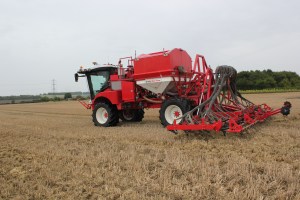
Fitting the Bateman platform with Weaving Sabre Tine coulters gives much more direct drilling flexibility at Manor Farm, especially where trash levels are high.
A 320hp low ground pressure Bateman RB-Trac platform has been switched from Horsch Pronto disc coulters to Weaving Sabre Tines, allowing direct drilling into stubbles, even where there’s plenty of trash.
“We’ve always taken pride in only working the ground at the right time and in the right way to leave our soils in the best possible order,” stresses David. “We all carry spades whenever we cultivate to ensure this. The new regime will give us even more ability to get our crop establishment spot-on, coupled with altogether less pressure on the ground.”
Around 160ha of the arable ground gets a 22t/ha application of sewage cake from Thames Water every year. Transport costs unfortunately make digestate from the AD plant prohibitive. So there’s also a straw-for-muck deal with a local dairy unit.
This may be brought in house through a planned bed-and-breakfast partnership for up to 50 beef cattle with a local rearer. This will see an extra 40ha of short-term leys in the rotation while the AB15 areas will provide a final cut of big bale silage every two years.
The areas of AB15 are part of a Stewardship scheme that brings in carefully-sited grass, pollen and nectar, and wild bird margins, providing links to woodland and other valuable habitats. The business is one of the founder members of the Southern Streams cluster group of farmers managing 9000 ha of land in the River Kennet catchment.
The cover crop mixes of linseed, berseem clover, black oats, phacelia, buckwheat and vetches are all mixed on-farm to a recipe developed with Agrii from straights bought-in or home-grown for the greatest value.
“We grow them for their roots and ground cover, more than anything else,” points out Russell. “We don’t want a massive biomass to have to get rid of ahead of early barley sowing. Stow Longa research underlines that the real value of cover cropping lies in holding rather than improving soil structure as well as protecting the soil surface. So, these are our key aims.”
The spring planting opportunity, later wheat sowing and minimum soil movement at drilling help a robust pre-emergence herbicide programme keep on top of grassweeds, he adds.
“Our nutrient use efficiency focus is first and foremost on planting as early as we can in the autumn – with the OSR, in particular – and winter cereals wherever the blackgrass risk isn’t too high,” explains David. “That way we get as much nutrition into our crops as possible from increasingly healthy soils so we can be less reliant on fertiliser.
“We’ve also switched all our N application to liquid applied through the Bateman for the greatest accuracy across our 40m tramlines. We’re well on course to achieve our current target of a 10-15% reduction in nitrogen use with no loss in yield,” he says.
Crops are fed for potential, however, so he wouldn’t shy from an opportunity to produce more. “After all, productivity is all about the output we can achieve per unit of input. And the more we do this, the more land and resource we can afford to put into the environmental benefits we all want.”
Green Horizons
The farmer network is part of Agrii’s ambitious Green Horizons plan of practical action to improve the sustainability of UK food and farming.
Focussed on increasing farm productivity and viability, providing integrated whole farm solutions, improving soil resilience, enhancing the environment, and extending stakeholder engagement, this initiative brings together the best scientific intelligence and farm experience to inform future improvement action.
Network growers are working alongside Agrii’s extensive variety, soil resilience, IPM and other trial work, and collaborative projects with a range of partners to share ideas, test approaches and showcase progress.
Up-to-date information and a series of specialist insight reports is available here.
This article was taken from the latest issue of CPM. For more articles like this, subscribe here.

